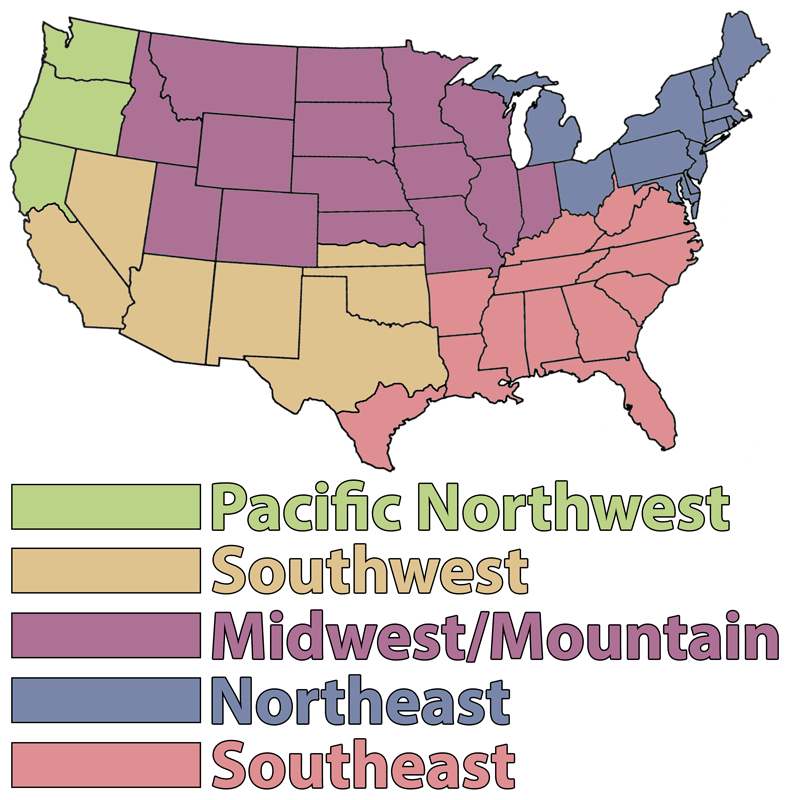After broccoli head is harvested, the plant continues to grow side shoots.
Gardening "To Do" Tips by Month for Plainfield, NJ
Garlic and onions are ready when their tops start to bend over. Remove their tops after they’ve dried for a couple weeks and store in a cool place.
Slugs? Put out shallow dishes of beer; handpick in the early morning. Also, deter with eggshells and other sharp objects.
During these warmer months, raise the mowing height to 2.5 to 3 inches. Water your lawn with 1 inch of water per week to ensure healthy growth.
Harvest summer squash when it’s young and tender (8 inches).
Prevent weeds from seeding; this will mean fewer weeds next year. Pull weeds as they grow and use mulch in your flower beds to prevent them from sprouting.
Feed your roses at mid-month to encourage more flowering.
Once melon vines have set three or four fruits, remove any new blossoms. The remaining fruits will benefit from this, and you will still have plenty.
When there is less than an inch of rain in a week, water extra. Water in early morning.
Late this month, plant iris and daylilies. Prepare soil now for fall planting.
Don’t water your melons at the base of the stems. Doing so can cause rot. Build up a little earth around the stems to keep water away.
Mulching is an important job to keep up with in July. Organic mulches break down over time, so be sure to check the mulch around your plants. Keep a 3- to 4-inch layer of mulch around your plants to retain moisture. Also keep a thick layer of mulch around the roots of trees and shrubs.
Dig up and divide crowded spring-blooming bulbs whenever they are dormant.
As the weather warms up, do not neglect your watering. Water deeply in the morning and avoid light sprinklings. Water at the roots, not on the foliage.
Water your containers twice a day. Apply a slow-release fertilizer every 2 weeks.
Generally, trees and shrubs need deep watering every 10 to 14 days to a depth of 3 inches with a hose at the roots. Do not fertilize, so that they can start preparing for winter dormancy.
Start herbs such as parsley, dill, and basil in pots for indoor use over the winter.
If white crust develops in containers, it’s salt buildup; remove and water heavily to flush out salts.
Remove annual flowers that have finished flowering - plus, any faded flowers.
You can sow a fall crop of bush beans now. Plant seeds two inches deep to protect them from the hot Sun. You can sow other vegetable seeds for an autumn yield, too, by planting them just a little deeper than you did in the spring. The best time to plant is after a rain shower.
Remove tomato suckers to keep the energy focused on the fruit on main branches.
Harvest tomatoes, zucchini, beans, and other fruiting crops frequently to encourage production and avoid attracting pests.
If your tomatoes have “blossom end rot,” avoid uneven watering. Mulch will help moderate the fluctuating moisture levels that nature provides.
Snip off the old flower clusters from rambler roses to encourage them to bloom all summer.
Lightly fertilize long-season plants, such as onions, tomatoes, and peppers, to help encourage growth.
Sow vegetable seeds for your fall garden: carrots, beets, turnips, collards, Chinese cabbage, snap beans, radish, kohlrabi, endive, kale, rutabagas, and summer squashes.
Pinch back mint, oregano, and savory to promote bushier growth.
Fertilize your houseplants frequently to ensure vigorous growth.
Newly planted trees and shrubs need one to two thorough soakings per week and lawns need 1 to 1.5 inches of water per week. Soak, don’t sprinkle.
If you have any houseplants sitting directly in the window, make sure the light is filtered or the plant is moved to a site out of direct sunlight. The windowpane intensifies the heat, and you don’t want to scorch your plants.
Finish pruning spring-flowering shrubs by mid-month.
If your trees have any yellow or undersize foliage, start feeding them regularly. Be sure not to overfeed them.
Annuals and perennials can be planted at any time to fill in blank spaces in the garden.
Set out broccoli, cabbage, and cauliflower transplants for your fall garden.
Remove any dead flowers from your annuals and perennials to encourage new growth.
Lightly fertilize tomatoes and peppers. Don’t overfertilize.
Remove any spent flowers from annuals to ensure continued blooming.

